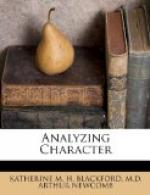In “Increasing Home Efficiency,” by Martha Brensley Bruere and Robert W. Bruere, we read:
“We have pretty definitely grasped the idea that the labor market must be organized, because it is for the social advantage that the trades should be neither over-nor under-supplied with workers; but it seems to shock people inexpressibly to think that the demand for ministers and teachers and doctors should be put in the class with that for bricklayers and plumbers. And yet the problem is quite as acute in the middle class as among the wage-workers. Take the profession of medicine, for instance, a calling of the social value of which there can be no question, and which is largely recruited from the middle class. The introduction of the Carnegie Foundation’s Report on Medical Education says:
“’In a society constituted as are our Middle States, the interests of the social order will he served best when the number of men entering a given profession reaches and does not exceed a certain ratio.... For twenty-five years past there has been an enormous over-production of medical practitioners. This has been in absolute disregard of the public welfare. Taking the United States as a whole, physicians are four or five times as numerous in proportion to population as in older countries, like Germany.... In a town of 2,000 people one will find in most of our States from five to eight physicians, where two well-trained men could do the work efficiently and make a competent livelihood. When, however, six or eight physicians undertake to gain a living in a town which will support only two, the whole plane of professional conduct is lowered in the struggle which ensues, each man becomes intent upon his own practice, public health and sanitation are neglected, and the ideals and standards of the profession tend to demoralization.... It seems clear that as nations advance in civilization they will be driven to ... limit the number of those who enter (the professions) to some reasonable estimate of the number who are actually needed,’
“And in the face of this there were, in 1910, 23,927 students in preparation to further congest the profession of medicine! It’s an inexcusable waste, for, though there’s much the statistician hasn’t done, there’s little he can’t do when he sets his mind to it. If he can estimate the market for the output of a shoe factory, why not the market for the output of a professional school? It ought to be possible to tell how many crown fillings the people of Omaha will need in their teeth in 1920 and just how many dentists must be graduated from the dental schools in time to do it.”
PROBLEMS FOR LAWYERS AND PREACHERS
So much for the physician. While we have not at hand any exact statistics in regard to lawyers, there is a pretty general feeling amongst all who have studied the subject that the legal profession is even more over-crowded than the medical. God alone knows all the wickednesses that are perpetrated in this old world because there are too many lawyers for proper and necessary legal work and so, many of them live just as close to the dead line of professional ethics as is possible without actual disbarment. And yet, with all their devices and vices, the average lawyer is compelled to get along upon an income of less than $1,000 a year.




